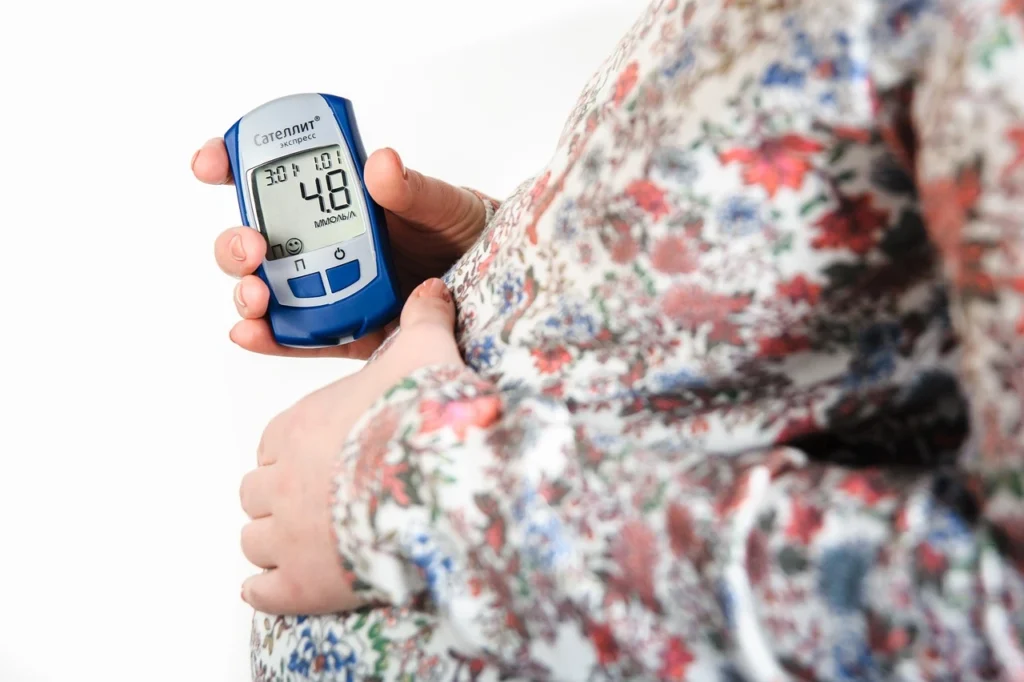Diabetes and Pregnancy
Diabetes is a condition where the body stops producing insulin or does not produce sufficient insulin, due to which our body struggles to regulate blood sugar level. If a woman develops this disease during pregnancy or conceives a baby while already living with diabetes, it requires special attention. The condition of diabetes during pregnancy is complex, as it affects both the health of the mother and the baby’s growth. Proper medical treatment and careful monitoring are essential to ensure a safe pregnancy and a healthy baby and also reduce any long-term complications.
There are two main conditions of diabetes during pregnancy:

Pre-existing diabetes:
Some women develop type 1 or type 2 diabetes before conception.
Gestational diabetes:
In this condition women develop diabetes during pregnancy. Gestational diabetes is not very concerning and often disappears after delivery. However, there are still risks during pregnancy, and the mother has a high chance of developing typë 2 diabetes later in life.
What Diabetes Means for the Mother
For expecting mothers, diabetes significantly requires pregnancy management. Women with diabetes during pregnancy need more medical check-ups and require uncompromising lifestyle adjustments. The complications that a pregnant diabetic woman can face include:
- Preeclampsia:
It is a condition in which you can cause organ damage due to a high rise in blood sugar level. - Increased risk of caesarean delivery:
If the size of the baby is large or the mother is facing any complications during labour. - Excessive amniotic fluid (polyhydramnios):
In this condition there is more amniotic fluid than normal, and it can increase preterm labour risk. - Urinary tract infections:
As higher sugar levels may motivate bacterial growth.Women with pre-existing diabetes need to manage blood glucose carefully before and during
pregnancy. Chances of miscarriage and birth defects can rise due to uncontrolled diabetes during early pregnancy. Therefore, the mother needs to maintain her blood sugar level by consuming a healthy diet, exercising, and taking medication.
What Diabetes Means for the Baby
A baby born to a mother with diabetes has to face some challenges. When blood sugar in the mother’s body is high, it crosses the placenta, and as a result, the baby’s pancreas starts producing extra insulin. This can lead to the following issues:
- Macrosomia (increasing baby size): In this condition the size of the baby may increase excessively, leading to difficult labour which leads to the need for caesarean delivery.
- Premature birth:
High glucose levels in the mother’s bloodstream may trigger early labour. - Low blood sugar (neonatal hypoglycemia) after birth:
Baby’s sugar level can drop instantly after delivery due to the sudden removal of the maternal glucose supply, as the baby was producing more insulin during pregnancy. - Breathing difficulties:
If a baby is born early, then it might struggle with lung development, which causes breathing issues. - Long-term health risks:
There are higher risks of obesity and type 2 diabetes in children born from diabetic pregnancies.
Risk Factors of Diabetes in Pregnancy
It is not necessary that all women face the same conditions of developing gestational diabetes or pre-existing diabetes complications. Several risk factors are involved, including:
- Family history with type 2 diabetes
- Obesity or being overweight.
- Previous history of gestational diabetes in earlier pregnancies.
- If age is over 30 years at the time of conceiving
- Polycystic ovary syndrome (PCOS),
- Inactive or lazy lifestyle and unhealthy diet.
- History of large babies (macrosomia)
Doctors can plan early screening and make preventive strategies if they are aware of these factors.
Cure or Prevention:
- Diabetes during pregnancy cannot always be cured; however, it can be managed successfully. Treatment or preventive steps are taken after examining whether it is pre-existing diabetes or gestational diabetes.
Healthy Diet:
Blood sugar level in the body can be maintained by eating a balanced diet like whole grains, vegetables, controlled portions of carbs and lean proteins. - Regular Exercise:
Including mild activities in your lifestyle, such as walking or prenatal yoga, can help to reduce weight gain and manage glucose levels in the body. - Blood Sugar Monitoring:
Keep a regular check of blood sugar level to detect early fluctuations. - Insulin or Medication:
Insulin therapy or oral medicines are prescribed by doctors to some women that help to maintain glucose levels. - Prenatal Care:
Ultrasounds, frequent doctor visits and tests help monitor the mother’s and baby’s well-being.
What Happens After Birth
Delivering the baby does not mean the end of medical attention for both mother and child. Instead, post-delivery care is highly appreciated.
For the Mother:
- Women with gestational diabetes must undergo follow-up glucose testing around 6 to 12 weeks after delivery to ensure stability.
- Mothers with gestational diabetes have a higher risk of developing Type 2 diabetes later in life; that is why they need long-term lifestyle changes.
- Breastfeeding is helpful in stabilising maternal blood sugar and offers health benefits for the baby.
For the Baby:
- In the first few hours after birth babies may need monitoring for low blood sugar levels.
- If they are experiencing breathing issues or hypoglycaemia, then they may require admission to neonatal intensive care.
- To monitor growth, development, and potential risks associated with maternal diabetes, regular paediatric check-ups are required.
Conclusion
Diabetes during pregnancy results in many challenges, but with awareness, management and timely diagnosis, both mother and baby can enjoy a safe, healthy life. Women can take control of their health by understanding what diabetes during pregnancy means and what it can cause.